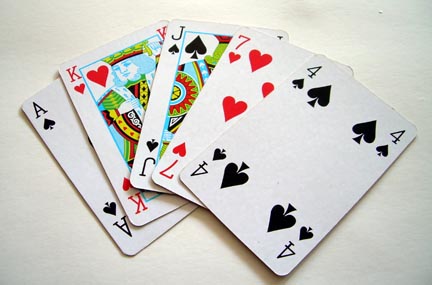

Pick a Card, Any Card ...
When designing your own games, it's convenient to start with materials that are already on hand. Almost any deck of playing cards - from "regular" cards to Uno or Skip-Bo - can be easily used in designing your own math game.
You can also find decks that have specific themes which will appeal to your child. For example, in our household we have Star Wars sets and Spider Man sets. Younger kids, in particular, just like looking at the pictures on the cards.
Children also enjoy the physicality of card games; they like shuffling, dealing, holding, and playing the cards.
Card Arithmetic
The reason that playing cards are a natural fit for math games is that they generally contain several suits with numbers from 2-10 (aces can be counted as 1's). This makes it easy to practice basic arithmetic facts with cards.
To customize your game, all you have to do is remove any numbers that have not been learned (as well as face-cards). For example, if your child has not learned the plus-seven facts, just take the sevens out of the deck.
Some Ideas
When I was growing up, the family's favorite game was "Casino." The object of this game is to catch tricks through matching or adding (e.g., a king will catch a king, and a nine will take a six and a three). So, all those years I was playing a math game and didn't even know it!
My vote for best card-based math game goes to a solitaire called "Pyramid," which I've included in the "Games" section. In "Pyramid," two cards adding up to a given number (like 10) are removed from the board. This is great practice for the "making ten" facts, which are particularly important.
For children who are not ready for arithmetic yet, card matching games are best. You could design your own memory game that uses two suits (for example, spades and hearts).
The possibilities are endless!